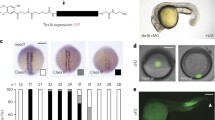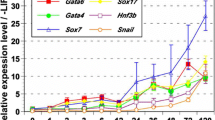Abstract
In an attempt to define the pattern of developmental expression of AP-2rep and AP-2 in Xenopus embryos, we cloned a Xenopus AP-2rep cDNA. The AP-2rep message was localized in the organizer region at the gastrula stage whereas AP-2 was expressed ventro-laterally in the animal hemisphere. Later, AP-2rep was expressed in the entire neural tissue at the neurula stage while AP-2 was predominantly expressed in the cranial neural crest areas. The endogenous expression of AP-2 in the neural crest area was diminished by ectopic injection of AP-2rep RNA, suggesting a role for AP-2rep in the differentiation of neural tissues by restricting the expression of AP-2 in the Xenopus embryo.



Similar content being viewed by others
References
Bieker JJ (2001) Krüppel-like factors: three fingers in many pies. J Biol Chem 276:34355–34358
Bourguignon C, Li J, Papalopulu, N (1998) XBF-1, a winged helix transcription factor with dual activity, has a role in positioning neurogenesis in Xenopus competent ectoderm. Development 125:4889–4900
Chazaud C, Oulad-Abdelghani M, Bouillet P, Decimo D, Chambon P, Dolle P (1996) AP-2.2, a novel gene related to AP-2, is expressed in the forebrain, limbs and face during mouse embryogenesis. Mech Dev 54:83–94
Hemmati-Brivanlou A, de la Torre JR, Holt C, Harland RM (1991) Cephalic expression and molecular characterization of Xenopus En-2. Development 111:715–724
Imhof A, Schuierer M, Werner O, Moser M, Roth C, Bauer R, Buettner R (1999) Transcriptional regulation of the AP-2α promoter by BTEB-1 and AP-2rep, a novel wt-1/erg-related zinc finger repressor. Mol Cell Biol 19:194–204
Kawahara A, Dawid IB (2000) Expression of the Krüppel-like zinc finger gene bilkf during zebrafish development. Mech Dev 97:173–176
Kawahara A, Dawid IB (2001) Critical role of biklf in erythroid cell differentiation in zebrafish. Current Biol 17:1353–1357
Kikkawa M, Yamazaki M, Izutsu Y Maeno M (2001) Two-step induction of primitive erythrocytes in Xenopus laevis embryos: signals from the vegetal endoderm and the overlying ectoderm. Int J Dev Biol 45:387–396
Luo T, Matsuo-Takasaki M, Thomas ML, Weeks DL, Sargent TD (2002) Transcription factor AP-2 is an essential and direct regulator of epidermal development in Xenopus. Dev Biol 245:136–144
Luo T, Leedagger YH, Saint-Jeannet JP, Sargent TD (2003) Induction of neural crest in Xenopus by transcription factor AP2α. Proc Natl Acad Sci USA 100:532–537
Mitchell PJ, Wang C, Tjian R (1987) Positive and negative regulation of transcription in vitro: Enhancer-binding protein AP-2 is inhibited by SV40 T antigen. Cell 50:847–861
Monge I, Mitchell PJ (1998) DAP-2, the Drosophila homolog of transcription factor AP-2. Mech Dev 76:191–195
Moser M, Imhof A, Pscherer A, Bauer R, Amselgruber W, Sinowatz F, Hofstadter F, Schule R, Buettner R (1995) Cloning and characterization of a second AP-2 transcription factor: AP-2 β. Development 121:2779–2788
Nieuwkoop PD, Faber J (1967) Normal table of Xenopus laevis (Daudin). North-Holland, Amsterdam
Schorle H, Meier P, Buchrt M, Jaenisch R, Mitchell PJ (1996) Transcription factor AP-2 essential for cranial closure and craniofacial development. Nature 381:235–238
Schuierer M, Hilger-Eversheim K, Dobner T, Bosserhoff AK, Moser M, Turner J, Crossley M, Buettner R (2001) Induction of AP-2α expression by adenoviral infection involves inactivation of the AP-2rep transcriptional corepressor CtBP1. J Biol Chem 276:27944–27949
Shain DH, Zuber MX (1996) Sodium dodecyl sulfate (SDS)- based whole-mount in situ hybridization of Xenopus embryo. J Biochem Biophys Meth 31:185–188
Thompson JD, Higgins DG, Gibson TJ (1994) CLUSTAL W: improving the sensitivity of progressive multiple sequence alignment through sequence weighting, positions-specific gap penalties and weight matrix choice. Nucleic Acids Res 22:4673–4680
West-Mays JA, Clyle BM, Piatigorsky J, Papagiotas S, Libby D (2002) Ectopic expression of AP-2α transcription factor in the lens disrupts fiber cell differentiation. Dev Biol 245:13–27
Zhang J, Hagopian-Donaldson S, Serbedzija G, Elsemore J, Plehn-Dujowich D, McMahon AP, Flavell RA, Williams T (1996) Neural tube, skeletal and body wall defects in mice lacking transcription factor AP-2. Nature 381:238–241
Acknowledgements
We thank Drs. T. Sargent, M. Taira and N. Papalopulu for supplying of plasmids (AP-2, En-2, and BF-1, respectively). This work was partly supported by a grant-in-aid from The Ministry of Education, Science and Culture of Japan (to M.M.).
Author information
Authors and Affiliations
Corresponding author
Additional information
Edited by R.P. Elinson
Rights and permissions
About this article
Cite this article
Gotoh, M., Izutsu, Y. & Maéno, M. Complementary expression of AP-2 and AP-2rep in ectodermal derivatives of Xenopus embryos. Dev Genes Evol 213, 363–367 (2003). https://doi.org/10.1007/s00427-003-0336-6
Received:
Accepted:
Published:
Issue Date:
DOI: https://doi.org/10.1007/s00427-003-0336-6




